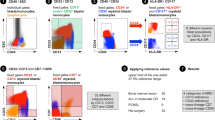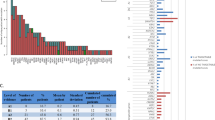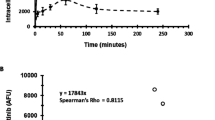Abstract
The wide discrepancies in the frequency of ‘positive’ samples for multidrug resistance (MDR) phenotype within the same type of tumor observed in the literature justified the need for the definition of consensus recommendations. To define standard techniques of MDR phenotype measurement, we ran a large multicentric evaluation of the different methods available. Thirty-six French centers participated in the study, and 742 samples of 2–10 × 106 viable cells were sent by overnight express mail between December 1993 and February 1996. The same batches of MRK16, 4E3 and UIC2 were used. Nineteen samples of leukemia (12 AML, 1 ALL, 6 lymphoproliferative syndromes) and six leukemic cell lines with different levels of MDR expression were tested. Five meetings reached agreement concerning the guidelines for each technique, except immunocytochemistry. The 19 fresh samples were tested by each center using one to four techniques among cytofluorometry, immunocytochemistry, functional tests and RT-PCR. Five samples were diagnosed as ‘negative’ according to local criteria, with few discordant results (0 to 16% of ‘positive’ results). For all the 14 remaining samples, large discrepancies were observed from center to center, and from one technique to another. No correlations could be found between techniques. Flow cytometric analysis of cells already exposed to MRK16 or control IgG2A, fixed in paraformaldehyde and sent to centers did not reduce the discrepancies between centers in two of the four samples with moderate expression, emphasizing the role of histogram interpretation. The use of alternative monoclonal antibodies (4E3 and UIC2) did not reduce the discrepancies observed. In a second step, the K562 parental cell line, a low resistant subline (K562/HHT100, ×7 resistance index to DNR) and a high resistant subline (K562/HHT300, ×125 resistance index to DNR) were sent blindly three times, with an increasing level of recommendations for flow cytometry. Dramatic improvements were observed in cytometric results when the result was expressed as the ratio of arithmetic mean of fluorescence of antibody (10 μg of MRK16)/arithmetic mean of fluorescence of control (10 μ g IgG2A): the proportion of expected results increased from 61 to 100% for K562, and from 37 to 85% for K562/HHT100. For uptake and drug efflux measurements, the use of 1 h uptake of 0.1μ M of rhodamine, followed by 1 h efflux ±10 μ M of verapamil, permitted an increased reproducibility of the technique from 71 to 100% for K562 and K562/HHT100. Whatever the technique used, concordant results were obtained for K562/HHT300. The immunocytochemistry, using several antibodies (MRK16, JSB1 and C219) gave many non-interpretable results (44%), due to a frequent high background and discordant results between antibodies in the same centers, and discordant conclusions between centers. The group does not recommend this technique for circulating tumoral cells.
This is a preview of subscription content, access via your institution
Access options
Subscribe to this journal
Receive 12 print issues and online access
$259.00 per year
only $21.58 per issue
Buy this article
- Purchase on Springer Link
- Instant access to full article PDF
Prices may be subject to local taxes which are calculated during checkout
Similar content being viewed by others
Author information
Authors and Affiliations
Rights and permissions
About this article
Cite this article
Marie, JP., Huet, S., Faussat, AM. et al. Multicentric evaluation of the MDR phenotype in leukemia. Leukemia 11, 1086–1094 (1997). https://doi.org/10.1038/sj.leu.2400656
Received:
Accepted:
Issue Date:
DOI: https://doi.org/10.1038/sj.leu.2400656



